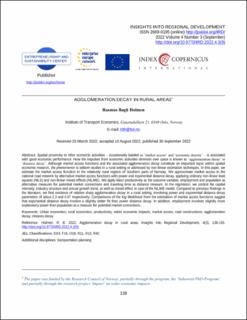| dc.contributor.author | Holmen, Rasmus Bøgh | |
| dc.coverage.spatial | Norway, Oslo | en_US |
| dc.date.accessioned | 2023-06-19T07:30:27Z | |
| dc.date.available | 2023-06-19T07:30:27Z | |
| dc.date.created | 2022-09-22T15:20:16Z | |
| dc.date.issued | 2022-09-30 | |
| dc.identifier.citation | Insights into Regional Development. 2022, 4 (3), 139-155. | en_US |
| dc.identifier.issn | 2669-0195 | |
| dc.identifier.uri | https://hdl.handle.net/11250/3071958 | |
| dc.description | Holmen, R. B. 2022. Agglomeration decay in rural areas, Insights into Regional Development 4(3): 139-155. https://doi.org/10.9770/IRD.2022.4.3(9) | en_US |
| dc.description.abstract | Spatial proximity to other economic activities – occasionally labeled as ‘market access’ and ‘economic density’ – is associated with good economic performance. How the impulses from economic activities diminish over space is known as ‘agglomeration decay’ or ‘distance decay’. Although market access functions and the associated agglomeration decay constitute an important topic within spatial economic research, the phenomenon is seldom studies in a rural setting or addressed by non-linear estimation techniques. In this paper, we estimate the market access function in the relatively rural regions of Southern parts of Norway. We approximate market access in the national road network by alternative market access functions with power and exponential distance decay, applying ordinary non-linear least squares (NLS) and non-linear mixed effects (NLME). We apply labor productivity as the outcome variable, employment and population as alternative measures for potential market connections and traveling time as distance measure. In the regression, we control for capital intensity, industry structure and annual growth trend, as well as mixed effect in case of the NLME model. Compared to previous findings in the literature, we find evidence of relative sharp agglomeration decay in a rural setting, involving power and exponential distance decay parameters of about 2.3 and 0.07 respectively. Comparisons of the log likelihood from the estimation of market access functions suggest that exponential distance decay involve a slightly better fit than power distance decay. In addition, employment involves slightly more explanatory power than population as a measure for potential market connections. | en_US |
| dc.description.abstract | Agglomeration decay in rural areas | en_US |
| dc.language.iso | eng | en_US |
| dc.publisher | Entreprenourship and Sustainablility Center | en_US |
| dc.rights | Navngivelse 4.0 Internasjonal | * |
| dc.rights.uri | http://creativecommons.org/licenses/by/4.0/deed.no | * |
| dc.subject | Urban economics | en_US |
| dc.subject | rural economics | en_US |
| dc.subject | productivity | en_US |
| dc.subject | wider economic impacts | en_US |
| dc.subject | market access | en_US |
| dc.subject | road constructions | en_US |
| dc.subject | agglomeration decay | en_US |
| dc.subject | distance decay | en_US |
| dc.title | Agglomeration decay in rural areas | en_US |
| dc.title.alternative | Agglomeration decay in rural areas | en_US |
| dc.type | Journal article | en_US |
| dc.type | Peer reviewed | en_US |
| dc.rights.holder | © 2022 by author(s) and VsI Entrepreneurship and Sustainability Center | en_US |
| dc.description.version | publishedVersion | en_US |
| cristin.ispublished | true | |
| cristin.fulltext | preprint | |
| cristin.qualitycode | 1 | |
| dc.identifier.doi | 10.9770/IRD.2022.4.3(9) | |
| dc.identifier.cristin | 2054456 | |
| dc.source.journal | Insights into Regional Development | en_US |
| dc.source.volume | 4 | en_US |
| dc.source.issue | 3 | en_US |
| dc.source.pagenumber | 139-155 | en_US |

